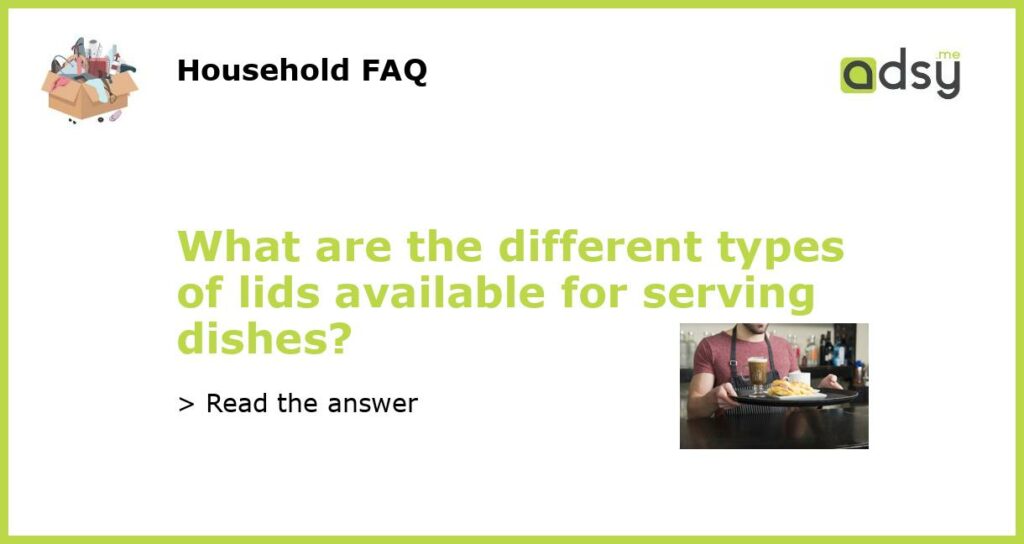Types of Lids for Serving Dishes
When it comes to serving dishes, the lid serves an important purpose. It helps to keep the food warm, prevents spills, and enhances the overall presentation of the dish. There are several types of lids available for serving dishes, each with their own unique features and benefits. In this article, we will explore some of the most common types of lids used for serving dishes.
Glass Lids
Glass lids are a popular choice for serving dishes because they are transparent, allowing you to easily see the contents of the dish. This type of lid is commonly used for serving casseroles, soups, and other dishes that need to be covered while cooking. Glass lids are oven-safe, making them versatile and convenient.
One of the main advantages of glass lids is that they do not react with food or absorb odors, ensuring that your dish tastes fresh and flavorful. Additionally, glass lids are easy to clean and are dishwasher-safe. They also provide an elegant and professional look to your serving dish.
Metal Lids
Metal lids are often used for serving dishes that require high heat or for dishes that need to be kept warm for an extended period of time. Stainless steel, copper, and aluminum are some of the most common metals used for making lids. These lids are durable, long-lasting, and provide excellent heat retention.
Metal lids can be found in a variety of styles and designs, from simple and functional to decorative and fancy. They are typically safe for use in the oven and are easy to clean. However, it’s important to note that metal lids can get hot, so it’s advisable to use oven mitts or a towel when handling them.
Silicone Lids
Silicone lids have gained popularity in recent years due to their versatility and practicality. These lids are made from food-grade silicone, which is a flexible and heat-resistant material. Silicone lids can be stretched to fit various sizes of serving dishes, making them a great choice for covering bowls, pans, and even irregularly shaped containers.
One of the main advantages of silicone lids is that they create an airtight seal, preventing leaks and spills. They are also microwave-safe, dishwasher-safe, and easy to clean. Silicone lids are a great eco-friendly alternative to plastic wrap or aluminum foil as they can be reused numerous times, reducing plastic waste.
Plastic Lids
Plastic lids are a common choice for serving dishes due to their affordability and convenience. These lids are lightweight, easy to handle, and often come in a variety of colors and styles. Plastic lids are typically designed to fit specific sizes of serving dishes, ensuring a secure and snug fit.
Plastic lids are microwave-safe and dishwasher-safe, making them ideal for reheating leftovers or storing food in the refrigerator. However, it’s important to note that some plastic lids may not be safe for use in the oven or freezer, so it’s always best to check the manufacturer’s instructions before using them.
Ceramic Lids
Ceramic lids are commonly used for serving dishes that require even heat distribution and slow cooking. These lids are often paired with ceramic baking dishes or Dutch ovens. Ceramic lids help to retain moisture and heat, ensuring that the dish is cooked evenly and the flavors are enhanced.
Ceramic lids are oven-safe and provide an attractive and rustic look to your serving dish. They are easy to clean and are dishwasher-safe, although handwashing is often recommended to preserve their longevity. Ceramic lids are a great choice for dishes that need to be braised, stewed, or slow-cooked.
In conclusion, when it comes to serving dishes, the type of lid you choose can greatly impact your cooking and presentation. Whether you prefer the transparency of glass, the durability of metal, the versatility of silicone, the affordability of plastic, or the even heat distribution of ceramic, there’s a lid available for every need and preference. Consider the type of dish you are serving and the specific requirements you have in mind when selecting a lid for your serving dish.






